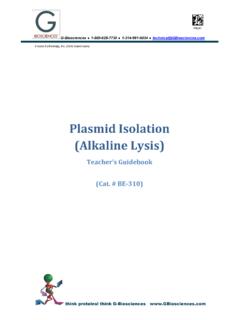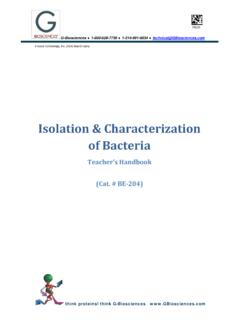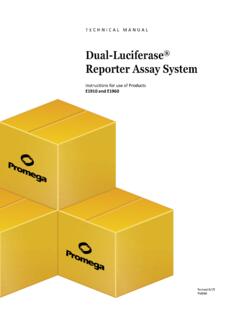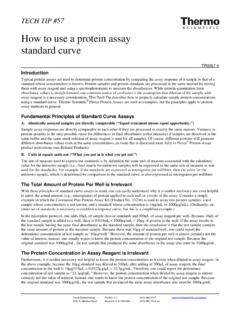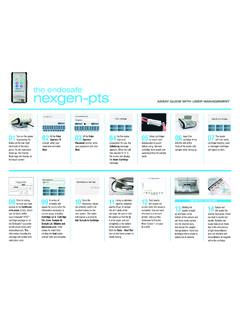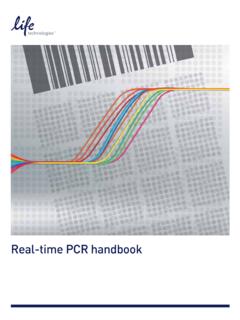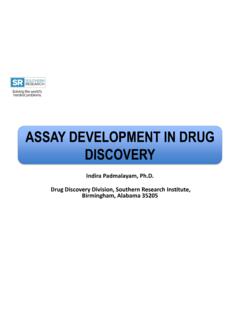Transcription of Bicinchoninic Acid (BCA) Protein Assay - G-Biosciences
1 064PR-02. G-Biosciences 1-800-628-7730 1-314-991-6034 A Geno Technology, Inc. (USA) brand name Bicinchoninic Acid (BCA) Protein Assay (Cat. # 786-570, 786-571, 786-890, 786-891). think proteins! think G-Biosciences INTRODUCTION .. 3. ITEM(S) SUPPLIED .. 3. STORAGE CONDITIONS .. 3. TOLERANCE GUIDE .. 4. PREPARATION BEFORE USE .. 5. STANDARD PREPARATION FOR STANDARD Assay .. 5. STANDARD PREPARATION FOR ENHANCED Assay : .. 5. PREPARATION FOR WORKING SOLUTION:.. 6. STANDARD PROTOCOL .. 6. MICRO-WELL PROTOCOL .. 6. TROUBLESHOOTING: .. 7. RELATED PRODUCTS .. 7. Page 2 of 8. INTRODUCTION. The Bicinchoninic Acid (BCA) Protein Assay is a highly sensitive colorimetric Assay that is compatible with detergent solubilized Protein solutions. The Bicinchoninic Acid (BCA). Protein Assay primarily relies on two reactions. Firstly, the peptide bonds in the Protein 2+. sample reduce Cu ions, in a temperature dependent reaction, from the copper + 2+. solution to Cu . The amount of Cu reduced is proportional to the amount of Protein present in the solution.
2 Next, two molecules of Bicinchoninic acid (BCA) chelate with +. each Cu ion, forming a purple-colored product that strongly absorbs light at a wavelength of 562 nm that is linear for increasing Protein concentrations between the range of The amount of Protein present in a solution can be quantified by measuring the absorption spectra and comparing with Protein solutions with known concentrations. The Bicinchoninic Acid (BCA) Protein Assay is suitable for quantifying Protein solutions in 1ml assays or in micro-wells. Cat. # 786-570 is for 500 x 1ml assays or 2,500 x Micro-well assays; Cat. # 786-571 is for 1,000 x 1ml assays or 5,000 x Micro-well assays. ITEM(S) SUPPLIED. Cat. # Cat. # Cat. # Cat. #. Description 786-570 786-571 786-890 786-891. BCA Solution, 250ml 2 4 2 4. Copper Solution, 10ml 1 2 1 2. Bovine Serum Albumin Standard 2 2 - - [2mg/ml], 5ml Non-Animal Protein Standard - - 2 2. [2mg/ml], 5ml STORAGE CONDITIONS. The kit is shipped at ambient temperature. Upon arrival, store the Protein standards at 4 C.
3 The remaining kit components should be stored at room temperature. When stored properly, the kit is stable for 1 year. Page 3 of 8. TOLERANCE GUIDE. 2-Mercaptoethanol, hydrazides, Not Compatible Ammonium sulfate, Imidazole, Ascorbic acid, Not Iron, Not Compatible Compatible Lipids, Not Compatible Brij 35, 5% N-Octyl Glucosidase, 5%. Catecholamines, Not Phenol red, Not Compatible Compatible Phosphate buffer, CHAPS, 5% SDS, 5%. CHAPSO, 5% Sodium azide, Creatinine, Not Compatible Sodium Chloride, 1M. Cysteine, Not Compatible Sucrose, 40%. Deoxycholic acid, 5% , DTT, 1mM Triton X-100, 5%. EDTA, 10mM Triton X-114, 1%. EGTA, Not Compatible Tryptophan, Not Compatible Glycerol, 10% Tyrosine, Not Compatible , 4M Tween 20, 5%. HEPES, Urea, 3M. Hydrogen peroxide, Not Uric acid, Not Compatible Compatible Zwittergent 3-12, Page 4 of 8. PREPARATION BEFORE USE. NOTE: The BCA and Copper Solutions may precipitate in cold weather or after long term storage, simply warm and stir to re-dissolve. Standard Preparation for Standard Assay Label 9 tubes with A-I and prepare the standards as indicated below.
4 The diluent used should be the same as used for the Protein samples. The following dilutions are suitable for triplicate Standard 1ml assays. Bovine Serum Albumin or Diluent Final Concentration Tube Non Animal Protein Standard ( l) ( g/ml). A 300 l from Stock 0 2,000. B 150 l from Tube A 150 1,000. C 150 l from Tube B 150 500. D 150 l from Tube C 150 250. E 150 l from Tube D 150 125. F 150 l from Tube E 150 G 150 l from Tube F 150 H 150 l from Tube G 150 I - 150 0 (Blank). Standard Preparation for Enhanced Assay : Label 7 tubes with A-I and prepare the standards as indicated below. The diluent used should be the same as used for the Protein samples. The following dilutions are suitable for triplicate assays. Bovine Serum Albumin or Diluent Final Concentration Tube Non Animal Protein Standard ( l) ( g/ml). A 100 l from Stock 700 l 250. B 400 l from Tube A 400 125. C 400 l from Tube B 400 D 400 l from Tube C 400 E 400 l from Tube D 400 F 400 l from Tube E 400 G - 400 0 (Blank). Page 5 of 8.
5 Preparation for Working Solution: To determine the amount of working solution required, use the following formula. The standard assays require 1ml and the micro-well assays require 200 l working solution: NOTE: For the test-tube methods, use 2ml working solution and sample. This will allow for 250 test tube assays per BCA Solution bottle (Total number of samples (standards and test samples) x (Number of replicates) x (Volume of WS/ sample). Combine 50 parts BCA solution with 1 part Copper solution, for example, for 10ml working solution combine 10ml BCA solution with Copper Solution. The mixed Working Solution should be a clear, green solution. STANDARD PROTOCOL. 1. Pipette 50 l of each standard and Protein samples into an appropriately labeled tube. 2. Add 1ml Working Solution to each tube, seal and vortex to mix. 3. Incubate the assays at 37 C for 30 minutes or room temperature for 2 hours. For the enhanced protocol, incubate at 60 C for 60 minutes. We recommend a waterbath for even heat transfer.)
6 4. Cool the tubes to room temperature and transfer 1ml sample to a cuvette. 5. Set a spectrophotometer to 562nm and blank with water. Read all the samples. 6. Subtract the average absorbance of the Blank standard from the samples and then prepare a standard curve to determine Protein concentrations. MICRO-WELL PROTOCOL. 1. Pipette 25 l of each standard and Protein samples into a microplate well. 2. Add 200 l Working Solution to each tube, seal and vortex to mix. 3. Cover the plate and incubate the assays at 37 C for 30 minutes. 4. Cool the plate to room temperature. 5. Measure the absorbance at 562nm, or between 540-590nm. 6. Subtract the average absorbance of the Blank standard from the samples and then prepare a standard curve to determine Protein concentrations. Page 6 of 8. TROUBLESHOOTING: Problem POSSIBLE Reason Solution Dialyze the sample (Use Tube-O- . DIALYZER ). Prepare Working Solution at a 50:2. ratio of BCA Solution to Copper No color visualized in A metal (copper) Solution tube chelator is present Use a Protein Assay that is unaffected by interfering agents.
7 (NI Protein Assay (Cat # 786-005).. or CB-X Protein Assay (Cat. # 786- 12X). A reducing agent is Dialyze the sample (Use Tube-O- . present DIALYZER ). Thiol containing agents Use a Protein Assay that is All tubes turn a very are present unaffected by interfering agents dark purple . (NI Protein Assay (Cat # 786-005). Catecholamines are . or CB-X Protein Assay (Cat. # 786- present 12X). Dialyze the sample (Use Tube-O- . DIALYZER ). Sample has a acid or Use a Protein Assay that is Low or Limited Color alkaline buffer that unaffected by interfering agents . development interferes with Assay (NI Protein Assay (Cat# 786-005).. compared to blank or CB-X Protein Assay (Cat. # 786- 12X). Ensure wavelength is 562nm, or Incorrect wavelength between 540-590nm Protein concentration Dilute samples too high Assayed samples Use a Protein Assay that is appear darker unaffected by interfering agents compared to Lipids or lipoproteins . (NI Protein Assay (Cat# 786-005). standards are present . or CB-X Protein Assay (Cat.)))))
8 # 786- 12X). RELATED PRODUCTS. Download our Protein Assays and Bioassays Handbooks. For other related products, visit our website at or contact us. Last saved: 3/8/2016 TNN. Page 7 of 8. Page 8 of 8.



